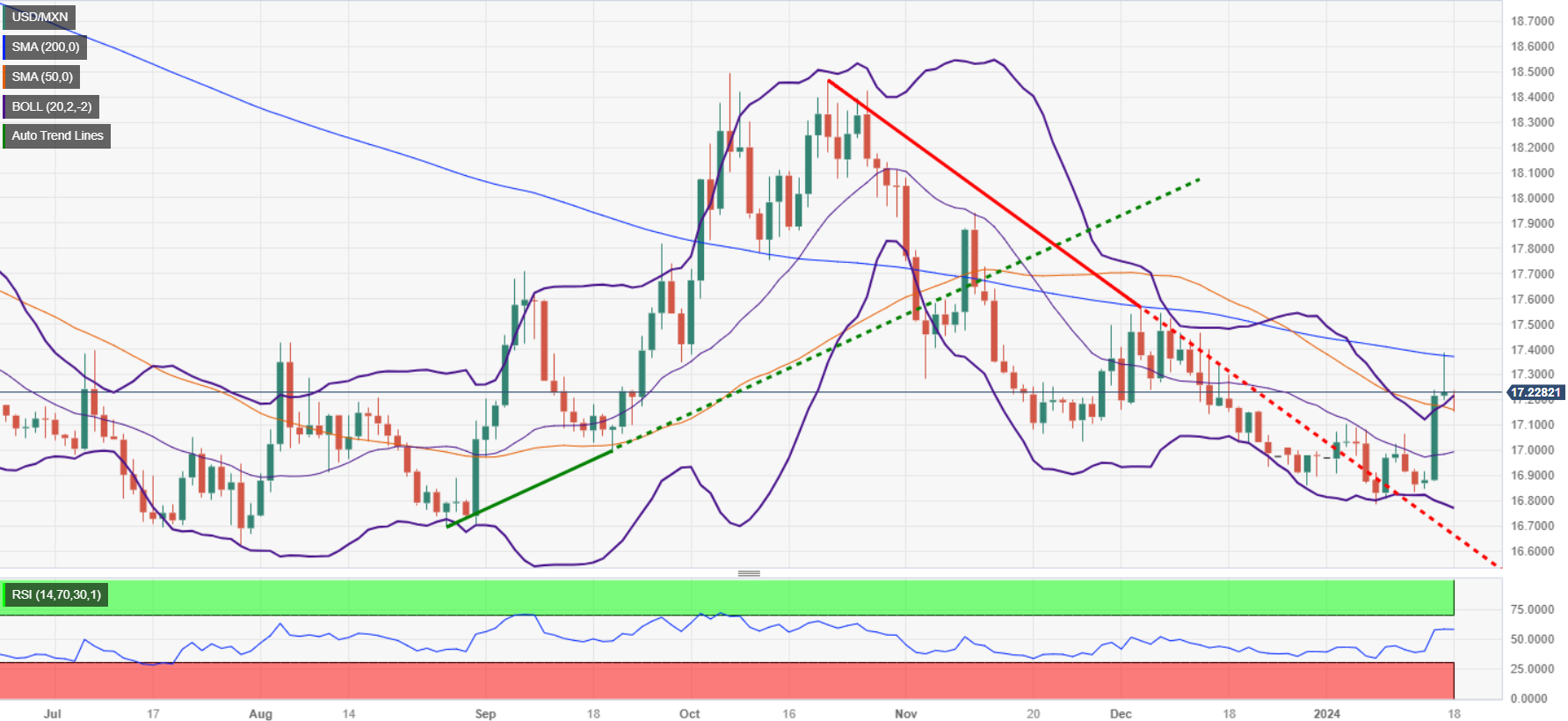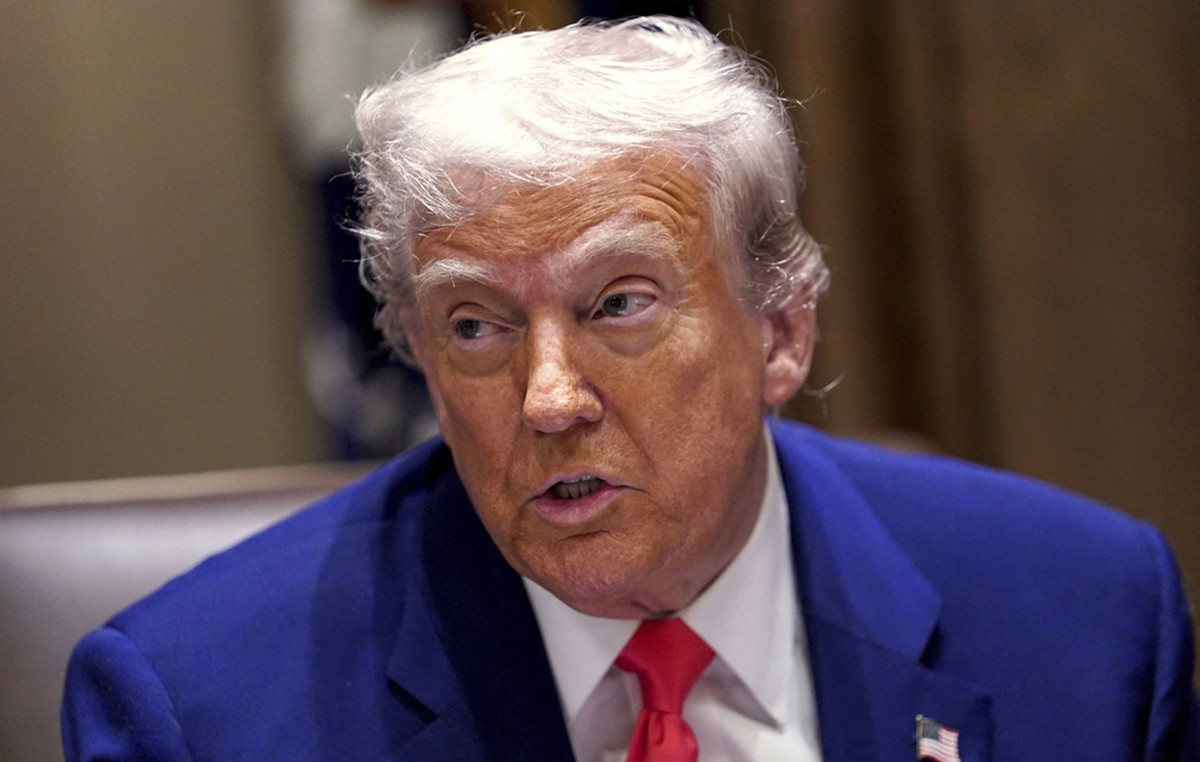- The Mexican Peso remains stable against the Dollar due to the improvement in employment data in the US, although the real estate sector presents mixed prospects.
- The fall in unemployment benefit applications indicates that the economy continues to resist, which strengthens the Dollar.
- USD/MXN traders are awaiting comments from the Fed and Mexican Retail Sales on Friday.
The Mexican Peso (MXN) remains virtually unchanged against the US Dollar (USD) following a series of mixed economic data from the United States (US) and rate cut bets from the Federal Reserve (Fed), that keep the Dollar at a generalized supply level. The pair USD/MXN It is trading at 17.18 today, after reaching a daily low of 17.15, up 0.07%, after falling below the 50-day SMA.
The US Bureau of Labor Statistics (BLS) revealed that jobless claims last week grew at a slower pace than the previous reading and expectations. The data reflects the rigidity of the labor market. Meanwhile, the US Department of Commerce (DoC) released data on housing starts and building permits, which were mixed, and failed to keep USD/MXN in positive territory. On Thursday, comments from Atlanta Fed President Raphael Bostic will make the news.
Daily Market Summary: Mexican Peso Holds Firm Despite Mixed US Economic Data
- The latest initial jobless claims report for the week ending January 12 revealed a decline to 187,000, below the previous week's numbers and the anticipated consensus of 207,000. This suggests that the labor market remains tight. This suggests that the labor market remains tight.
- Turning to the labor market, the Federal Reserve's latest Beige Book, released Wednesday, painted a more nuanced picture, reporting that “nearly every district cited one or more signs of a cooling labor market,” indicating some emerging signs of slowing employment growth in several regions.
- US housing data recently presented a mixed picture. Construction permits experienced an increase of 1.9% and reached 1,495 million, compared to 1,467 million in November and exceeding the forecast of 1.48 million. On the other hand, housing starts experienced a decrease, going from 1,525 million in November to 1.46 million in December, which represents a contraction of -4.3%.
- The strongest catalyst of the week has been the speech of the Governor of the Federal Reserve, Christopher Waller: “there is no reason to move as fast or cut as quickly as in the past.” This kept investors at bay, even though they support rate cuts if inflation ever declines.
- Additionally, December's Retail Sales and Industrial Production report has fueled speculation that the U.S. economy would likely grow 2.4% in the fourth quarter of 2023, Atlanta's GDPNow model shows. This sparked a reaction from federal funds rate (Rate) traders, who cut rate cut bets for 2024 from 175 basis points to just 150.
- The lack of data in Mexico keeps traders pending the latest inflation figures, which rose more than expected in general inflation, but the underlying data suggests that the Bank of Mexico (Banxico) has done a good job, slowing the price rise after raising rates to 11.25%.
- Although the minutes of the December meeting of Banxico (the Central Bank of Mexico) suggest that the central bank could consider easing its monetary policy, the December inflation report could hamper any move towards easing policy.
- Analysts at Standard Chartered noted: “We expect the policy rate to be cut to 9.25% by the end of 2024, although an official downward revision of the output gap could open the door to more aggressive rate cuts.”
- On January 5, a Reuters poll suggested that the Mexican peso could weaken 5.4% to 18.00 per dollar in the 12 months to December.
Technical Analysis: The Mexican Peso remains firm, while the USD/MXN oscillates around 17.20
The USD/MXN daily chart maintains a neutral-to-bullish bias, but a failure to decisively break the 200-day SMA at 17.37 exacerbated a pullback below the 17.20 area. A break of the 50-day SMA at 17.17 would pave the way to challenge the January 12 low at 16.82. The January 8 low at 16.78 could be a new pullback. Once these levels are breached, the next level of demand would be the August 28 cycle low at 16.69, ahead of last year's low at 16.62.
On the other hand, if buyers reclaim the 17.20 area, that could open the door to testing the 200-day SMA at 17.37. Once overcome, next resistance emerges at the 100-day SMA at 17.41, before the December 5 high at 17.56, before testing the May 23 high at 17.99.
USD/MXN Price Action – Daily Chart

Frequently Asked Questions about the Mexican Peso
What is MXN?
The Mexican Peso is the legal tender of Mexico. The MXN is the most traded currency in Latin America and the third most traded on the American continent. The Mexican Peso is the first currency in the world to use the $ sign, prior to the later use of the Dollar. The Mexican Peso or MXN is divided into 100 cents.
What is Banxico and how does it influence the MXN?
Banxico is the Bank of Mexico, the country's central bank. Created in 1925, it provides the national currency, the MXN, and its priority objective is to preserve its value over time. In addition, the Bank of Mexico manages the country's international reserves, acts as a lender of last resort to the banks and advises the government economically and financially. Banxico uses the tools and techniques of monetary policy to meet its objective.
How does inflation impact the MXN?
When inflation is high, the value of the Mexican Peso (MXN) tends to decrease. This implies an increase in the cost of living for Mexicans that affects their ability to invest and save. At a general level, inflation affects the Mexican economy because Mexico imports a significant amount of final consumption products, such as gas, fuel, food, clothing, etc., and a large amount of production inputs. On the other hand, the higher the inflation and debt, the less attractive the country is for investors.
How does the Dollar influence the Mexican Peso (MXN)?
The exchange rate between the USD and the MXN affects imports and exports between the United States and Mexico, and may affect demand and trade flows. The price of the Dollar against the Mexican Peso is affected by factors such as monetary policy, interest rates, the consumer price index, economic growth and some geopolitical decisions.
How does the Fed's monetary policy affect Mexico?
The exchange rate between the USD and the MXN affects imports and exports between the United States and Mexico, and may affect demand and trade flows. The price of the Dollar against the Mexican Peso is affected by factors such as monetary policy, interest rates, the consumer price index, economic growth and some geopolitical decisions.
Source: Fx Street
I am Joshua Winder, a senior-level journalist and editor at World Stock Market. I specialize in covering news related to the stock market and economic trends. With more than 8 years of experience in this field, I have become an expert in financial reporting.







